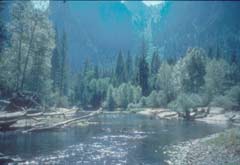| Dancing the Lindy hop in Atascadero, California, USA (2005). (Photo credit: Wikipedia) |
Over the last year I have discovered something amazing about myself - I have a right foot!
I’ve always known I have two feet – it’s just that I thought they were both left feet. Thanks to my understanding, patient – very patient (persistent) girlfriend, Jo, and several good dance instructors, like Susan Kosch of Colorado Mountain College, I have now found that one of my left feet is actually a right foot and I can actually dance a little bit when I have to
umm, get the opportunity.
I’m not talking about the funky, freewheeling, spastic kind of dancing I “learned” to do in high school and sometimes disturbingly displayed
at nightclubs and parties in my younger years. I’m talking Dancing with the Stars-style smooth, precise, crisp, elegant, wow- the-audience kind of dancing.
Well, ok, I can’t actually dance like that – yet, but I am a considerably better dancer than I used to be; and last Saturday night, while much of the rest of the town of Aspen was most likely carousing the bars and nightclubs or awaiting the Lyrid meteor shower, I did have the opportunity to work out that right foot again.
Every third Saturday of the month, from 6:30 PM to 10:00 PM, a dedicated group of 20 - 30 people gather at the Rio Grande Commons in downtown Aspen to trip the light fantastic for a few hours at The Aspen Community Social Dance. These events, hosted by local volunteers such as Junee Kirk, usually consist of two, one-hour lessons in various styles such as Fox Trot, Waltz, Swing, Salsa, Rumba, Country Three-Step, Lindy Hop, and more. The evening
is capped off by one and a half hours of open dancing.
The activities typically begin with an advanced/intermediate lesson for those dancers who discovered their right feet some time ago. This is followed by a beginning lesson for people like me who are just figuring this out, and if they’re a guy, have to be dragged in kicking and screaming. Actually, the screams are mostly silent, and the kicking part can be useful for practicing rhythm and for getting limbered up for the real action.
At the end of the evening, the instructors play a mix of music appropriate for many of the various styles, including the dances du jour, allowing you to practice all of slick moves you just learned while trying not to annoy and frustrate your partner at the same time.
Last Saturday’s lessons consisted of advanced Waltz and beginning Foxtrot. We decided to skip the beginning Foxtrot because we’re now experts as the result of taking ballroom dancing lessons from Susan at CMC (truthfully, we were just hungry and didn’t think we could hold up for three and a half straight hours of dancing without the sustenance – it’s a lot of exercise).
In the waltz lesson, we learned some new steps -- the slip step bridge, the twinkle, the promenade, the sachet, and the hook and spin. These are not necessarily exactly the correct names of the steps and, like my dancing itself, might be a little off, but that’s what I’ll call them for now.
We returned from dinner just in time to catch the last few minutes of the Foxtrot instruction. This was fortuitous because it was no longer completely beginner-oriented and we learned that we don’t have to just "slow, slow, quick-quick" – we can also "slow, quick-quick, slow, quick-quick." Wow!
During the open dancing, we waltzed, fox-trotted, tangoed, salsaed, and cha-cha-chaed, and we wore ourselves out (it’s a good thing we passed on the Foxtrot lesson). I also realized that I don’t have to be dragged to these dances
any more. Now that I’ve learned how to move both of my feet,
thanks to those classes at CMC and “practice, practice, practice”, I really enjoy these evenings. Thanks to Jo, I even have some special dancing shoes (one for the right and one for the left).
I am looking forward to the next Aspen Community Social Dance to prove, once again, that I don’t have two left feet or two right feet and that I have at least a modicum of rhythm. Watch out Dancing with the Stars!


